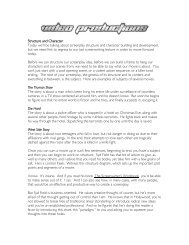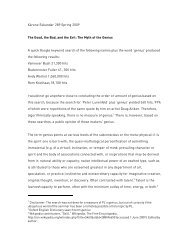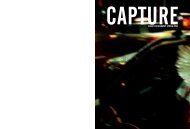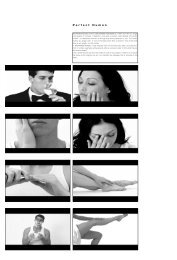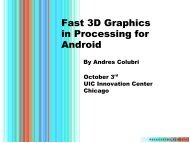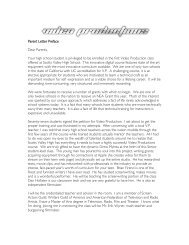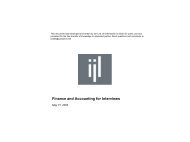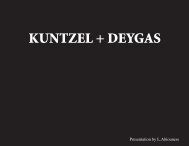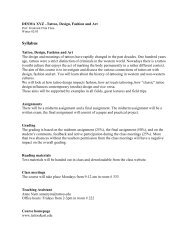UNIVERSITY OF CALIFORNIA Los Angeles - Users - UCLA
UNIVERSITY OF CALIFORNIA Los Angeles - Users - UCLA
UNIVERSITY OF CALIFORNIA Los Angeles - Users - UCLA
Create successful ePaper yourself
Turn your PDF publications into a flip-book with our unique Google optimized e-Paper software.
Tehnological Living In the 1960s, Archigram proposed new forms<br />
of cities with new environments where new technologies are possible<br />
everywhere; for example, a media city, a plug-in city, and an instant<br />
city, and those cities of imagination. These cities that were<br />
represented as graphic based works now became a reality in these days.<br />
Pedestrians are not just people who are passing by, but they are also<br />
people who can interact with multi-user environments such as<br />
mobile apparatus and locative media in urban spaces. These also can<br />
be defined as social and cultural spaces that allow telecommunication<br />
between people with different purposes.<br />
Figure 14. Blast Theory,<br />
Can You See Me Now,<br />
UK, 2001<br />
*A game that happens<br />
simultaneously online and on<br />
the streets. (down) An urban<br />
gamer running while playing<br />
the game.<br />
The apparatus is merged with physical space and recreates a<br />
different urban context. For instance, in one new media art genre<br />
there are locative games which use mobile devices such as the project<br />
Can you see me now. 14 Another example is happening now in Seoul,<br />
Korea. When people in Korea want to protest against the<br />
government’s policies, these days, they use mobile devices and media<br />
to communicate with other individuals, not only as a planning tool<br />
for arranging meetings, but also to report on situations in real-time<br />
through another media, such as internet communities. The following<br />
is a quote by Van Loon, explaining a multiplicity of rhythms in<br />
ordinary life:<br />
[E]veryday life consists of a multiplicity of rhythms. Everyday life thus<br />
entails a range of flows, each with their own ‘proper time’ (e.g, duration,<br />
pace, frequency). Likewise, we could argue that everyday life consist of<br />
multiplicity of spatialization, including forms of embodiment. If we were to<br />
use ‘space of places’, we would have to bear in mind the inherently<br />
dynamic, volatile, contested, unstable, and multiplicitous (rather than<br />
duplicitous) nature of ‘place’. 15<br />
With embedded ubiquitous computing technologies, urban life is<br />
now becoming a hybrid reality, i.e. a networked entity. New<br />
technologies such as mobile devices and locative media are making<br />
urban life more active and creative with nomadic and playful<br />
14<br />
http://www.blasttheory.co.uk/bt/work_cysmn.html (accessed June.10.2008)<br />
15<br />
Loon, Van J. “Social spatialization and everyday life.” Space and Culture, vol.5, no.2, p.88-<br />
95, 2002<br />
J.KIM_A LANDSCAPE <strong>OF</strong> EVENTS 22



